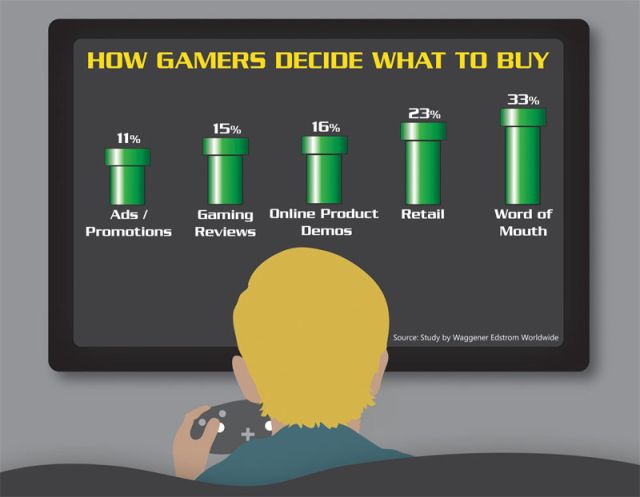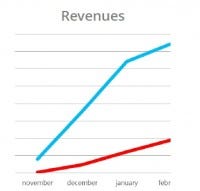
Featured Blog | This community-written post highlights the best of what the game industry has to offer. Read more like it on the Game Developer Blogs.
Evaluating the revenue contribution from both paying and non-paying players in Free to Play games. Original post from www.gamesmarketer.com

Original post from www.gamesmarketer.com
Aggressive monetization and targeting of high value players is receiving more and more attention from game developers, especially in the mobile channel. This had led to a more analytical approach to game creation. Now before I discuss the industry standard metrics of CAC (Customer Acquisition Cost), ARPU (Average Revenue per User) and LTV (Lifetime Value), I want to touch on something I am concerned is becoming overlooked in the Free to Play Market, the value of non-paying players.
Free to play is just one of many video games business models and the basic premise is that whilst the game itself is free to play or download, certain elements of the game are monetized to create revenue. This can be items, characters, time savers etc. that create the revenue that pays for the development and subsequent profitability of the game.
As the use of Free to Play expands amongst game makers so does the interest in maximizing revenue, which itself is not a bad thing, everyone want their business to be as profitable as possible. What I believe would be a dangerous trend would be to target solely, what for the purposes of this article I will call, “monetizable gamers”. If you are going straight after this demographic at the expense of a wider audience you will struggle if you want to be a worldwide success, especially if you want to be seen as real AAA title rather than say a casual game. This is due to the fundamental fact that Free to play works best at scale. You need lots of players to make free to play work, and a $0 price point is not enough anymore to bring in the crowds in an ever more competitive market. You need a good product, which is at its core fun to play. If you over-monetize your game and only go after the “whales” you ostracize your normal players and remove the whole purpose of the game, namely the fun.

It is for this reason that you need to be very careful with how you measure success. If you are chasing higher and higher LTV from gameplay changes you may actually be harming your overall profitability.
Just to be clear though, the people that pay to enjoy your game more are essential and you need them otherwise F2P just doesn’t work as a business. As with anything it’s about balance and while allowing and encouraging high value users to spend what they want, you really do need your non-paying players too, which seems to be a message that is getting lost in the frantic fishing for monetizable gamers. This creates the dangerous concept that non-paying users are worthless. I also believe that increasing your average order values and generally increasing the profitability of your game is best achieved via marketing and merchandising rather than solely gameplay tweaks.
What I really want to point out though is that just because nonpaying players don’t and maybe never will create in game revenue, you can to a certain extent give them a $ value. I am going to call this Social Value.
So how do non paying players generate revenue?
1. They bring new users
People who like your game, talk about it. So if you have 100 players and only 5 pay that leaves 95 players who don’t pay anything. However if your game is fun and enjoyable it stands to reason that all of your users may talk about your game and pass it on to their friends as a personal recommendation. Statistics show that there is no better source for qualified new users than someone referred by a friend.

So let�’s say that your 95 non-paying users on average convert a new user 50% of the time for the duration they play your game (47.5 new users). If we assume your average conversion rate is constant then 5% of these new users (which you acquired for free) will upgrade to paying players (2.4 new paying users). If your LTV of a paying player is $20, that’s $48 you would never have accounted for in your initial calculations. Now scale the numbers up to 1M users……
Of course due to the nature of personal recommendations it is exceptionally fuzzy to put an accurate number on how many people you could expect to have brought in. But given that 95% of you user base (or whatever the figure is in your game) do not pay, surely it makes sense to make everyone happy and passing on the word. What you can do to help this process is arm your users in every possible way to spread your game, via tools such as refer a friend offers, Social Media, Community projects and maybe even affiliate schemes.
So if you have no marketing budget and are seeing your number of users still increasing, this is happening via word of mouth, this is your nonpaying community hard at work getting more people to play your game. Now work out what it would have cost you to pay a marketing provider to get the same number of people to join your game, divide this by your current user base and that is the incremental marketing value your users are generating.
2. Players can show their appreciation in other ways.
Cross Promotion – If you have more than one title you have the perfect opportunity to cross promote you games between the two groups of players. In fact many companies employ a tactic whereby if a user is not converting in one game they will attempt to flip them into another. I would not condone forcing players out of one game into another, especially if they are an active player, but introducing them to you other products should be something you do as a matter of course.
Community Content – Some of the most interesting content you can have for your game and your website is fan produced. Given that the internet is alive with chatter about the benefits of content marketing surely harnessing your fan base to produce, artwork, fiction, forum and blog posts as well as video makes sense rather than trying to produce it yourself. On the question of video this can also be monetized via advertising if you retain the rights. Video usage is exploding at the moment with things like Twitch TV seeing exponential growth.
If your game is particularly in depth then you may find your community is likely to build a wiki which will also send you traffic and new users.
Events – Increasingly players are showing their appreciation of games by attending events. This can be seen with explosion of eSports over the last few years but also the many consumer events that now exists such as Blizcon
Merchandise - Once your franchise truly becomes a brand it starts to exist as something other than just a game. When this happens it opens up the door to merchandising and proliferating your brand even further. Many big games have numerous license agreements with manufacturers as well as their own merchandise stores which can generate huge revenues.
3. Advertising
Advertisers are looking for demographically targeted users and video games offer one of the best opportunities to reach and engage with them on a deep level. Whilst we traditionally think of TV as being the best way to reach the mass market, gaming is rapidly taking over. Gamers now account for huge segments of the population in the western world to one extent or another, though many people would not actually count themselves as a gamer. And whilst you can never be accurate about who saw your half time Super Bowl advert you know down to the unique user ID who saw an advert in a game. Advertising can be a key revenue driver for a game though it needs to be handled correctly. We have yet to get to a point where users feel comfortable with adverts in games in the same way we are with TV. Many use the removal of adverts as a perk for paying users in their game which can be interesting mechanic.
If you want to explore advertising product placement and 3rd party partnerships in more detail see my post on The Benefits and Pitfalls of Strategic Partnerships.
So before we move on to how you actually measure your metrics I think it’s important to state you need to understand all of your users, not just the paying ones if you are going to have a truly successful F2P game.
Beginners Metric Definitions
Note to any developers yet to launch their first title and therefore don’t have the data yet to make these calculations. Don’t try to guess these numbers! If you are guessing what your LTV or CAC might be without experience you are likely to end up in trouble. Better to look at some industry standards or ask other developers with similar product. For real disaster management then always expect to pay more for your marketing and earn less from your users. Normally with forecasting its best to have 3 forecasts for poor, average and excellent performance.
CAC = Customer Acquisition Cost
This is how much it costs you to get a new user. Depending on your company setup there may be a couple of ways to work this out. If you want to be absolutely scrupulous and include everything you can even factor in the wages of any staff who work on marketing. So take the cost of marketing over a given period including any other monies spent on salaries, revenue share, fees etc and divide it by the number of customers that the business acquired in that period.
ARPU = Average Revenue Per User
ARPU is simply the average amount of money generated per user, normally for the period of 1 month but you could use any time period you wanted. Many companies use ARPDU for daily check on what is going on. You can also segment this to ARPPU Average Revenue Per Paying User.
LTV = Lifetime Value
This is a fairly simple calculation, however there are quite a number of ways that you can work this out. As a rough starting point LTV is calculated by multiplying ARPU by the average player lifespan (which you can work out from churn rates). So if your ARPU (over a month) is $5 and your player lifecycle is 5 months then LTV = $25.
At the bottom of this post your will find an excellent infographic I found by kissmetrics which covers all the different ways you can work out LTV which you can then use to create an average LTV. The example they use is Starbucks but these calculations work for any business so long as you have data.
Use of Metrics
So to roughly gauge if what you are doing is making money you should now compare the CAC figure against the LTV figure. If your CAC figure is lower that means it is costing you less to acquire your users than you are making back from the game. This is a good thing! Ideally what you want to see however is that the LTV figure is several times the number of your CAC to start to cover everyone’s wages and pay the rent.
Note: Never rely solely on LTV and ARPU to make business decisions, you need to also be looking at your total revenue and user numbers for the period. As I mentioned at the beginning of the article these metrics do not tell the whole story.
If your numbers here are healthy it may be that you can afford to spend more money on marketing, though it would be wise to further analyze the data to decide where to focus this spend rather than diving straight in. By segmenting your data or even employing predictive modeling (something for another post) you can create super targeted marketing that works on a player by player basis.
In closing, what you need to remember about the above definitions is that they are metrics i.e. measurements of things that have already happened, they are not predictive. These are good indications that what you are doing is making you money but they cannot tell you if you will continue to do so or how to make more. They also are based entirely on the revenue you have seen during the period in question and nothing else. To re-iterate my earlier point if you now make fundamental gameplay changes based on chasing higher LTV and ARPU you could inadvertently alter your wider appeal and lose the ability to scale by not seeing the benefit of your nonpaying users. One final note is that these metrics are also averages and in a world of detail an average can be a dangerous thing to bet the farm on. The more detail you can get the better, so once you have got these basics the next steps would be to look at ARPU and LTV by user segments, either demographically or by play type or both. But that’s a story for another day.

Read more about:
Featured BlogsAbout the Author(s)
You May Also Like








